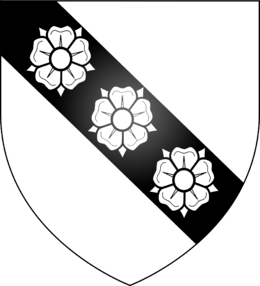Manor of Clovelly
The Manor of Clovelly is a historic manor in North Devon, England. Within the manor are situated the manor house known as Clovelly Court, the parish church of All Saints, and the famous picturesque fishing village of Clovelly. The parish church is unusually well-filled with well-preserved monuments to the lords of the manor, of the families of Cary, Hamlyn, Fane, Manners and Asquith. In 2015 the Rous family, direct descendants via several female lines of Zachary Hamlyn (1677–1759) the only purchaser of Clovelly since the 14th century, still own the estate or former manor, amounting to about 2,000 acres,[1] including Clovelly Court and the advowson of the parish church, and the village of Clovelly, run as a major tourist attraction with annual paying visitor numbers of about 200,000.[2]
Descent
Normans
Brictric/Queen Matilda
The manor of CLOVELIE was recorded in the Domesday Book of 1086 as held at some time in chief from William the Conqueror by the great Saxon nobleman Brictric, but later held by the king's wife Matilda of Flanders (c. 1031 – 1083).[3]
According to the account by the Continuator of Wace and others,[4] in his youth Brictric declined the romantic advances of Matilda and his great fiefdom was thereupon seized by her. Whatever the truth of the matter, years later when she was acting as Regent in England for William the Conqueror, she used her authority to confiscate Brictric's lands and threw him into prison, where he died.[5] Most of Matilda's landholdings, including Clovelly, descended to the Honour of Gloucester.[6]
Feudal barony of Gloucester
Brictric's lands were granted after the death of Matilda in 1083 by her eldest son King William Rufus (1087–1100) to Robert FitzHamon (died 1107),[7] the conqueror of Glamorgan, whose daughter and sole heiress Maud (or Mabel) FitzHamon brought them to her husband Robert de Caen, 1st Earl of Gloucester (pre-1100-1147), a natural son of Matilda's younger son King Henry I (1100–1135). Thus Brictric's fiefdom became the feudal barony of Gloucester.[8] The Giffard family later held Clovelly as feudal tenant of the Honour of Gloucester, and the Book of Fees records Roger Giffard holding Clovelly "from the part of Earl Richard",[9] that is Richard de Clare, 5th Earl of Hertford, 6th Earl of Gloucester (1222–1262), feudal baron of Gloucester. The feudal barony of Gloucester was soon absorbed into the Crown, when the Giffards became tenants in chief.
Giffard
Roger Giffard in 1242[11] held Clovelly as one knight's fee from Sir Walter Giffard of Weare Giffard. His son Matthew Giffard, tempore King Edward I (1272–1307), left two daughters and co-heiresses, one married to Stanton, the other to Mandevile. Matthew Giffard presumably died before 1314 as in that year[12] Clovelly was held jointly by John de Stanton and John Maundeville. In 1345[13] Clovelly was held by Sir John de Stanton and Robert Mandevill. It appears that on an eventual split of the Giffard estates Mandeville inherited Fonthill Gifford in Wiltshire whilst Stanton received Clovelly. John de Stanton left a daughter and sole heiress Matilde de Stanton, wife of John Crewkern of Childhey in Dorset. During the reign of King Richard II (1377–1399) Clovelly was sold to Sir John Cary (died 1395),[14] as is generally accepted, although the Devon historian Thomas Westcote (d. circa 1637) in his View of Devonshire suggested that the latter inherited it from his mother Margaret Bozum, daughter of Richard Bozum[15] apparently of the family seated at Bozum's Hele, in the parish if Dittisham, Devon.[16]
Cary

In the 14th century, Clovely was held by the Cary family:[18]
See main article: Cary family
Sources
- Vivian, Lt.Col. J.L., (Ed.) The Visitations of the County of Devon: Comprising the Heralds' Visitations of 1531, 1564 & 1620, Exeter, 1895, pp. 150–9, pedigree of Cary
- Lauder, Rosemary, Devon Families, Tiverton, 2002, pp. 131–6, Rous of Clovelly
- Griggs, William, A Guide to All Saints Church, Clovelly, first published 1980, Revised Version 2010
References
- ↑ Lauder, Rosemary, Devon Families, Tiverton, 2002, pp. 131–6, Rous of Clovelly, p.136
- ↑ Lauder, p.135
- ↑ Thorn, Caroline & Frank, (eds.) Domesday Book, (Morris, John, gen.ed.) Vol. 9, Devon, Parts 1 & 2, Phillimore Press, Chichester, 1985, part 1, 1:59 (Bideford). In the Domesday Book a heading above the entry for Northlew, two entries above the entry for Clovelly, states: Infra scriptas terras tenuit Brictric post regina Mathildis ("Brictric held the undermentioned lands and later Queen Matilda")
- ↑ Thorn, Caroline & Frank, (eds.) Domesday Book, (Morris, John, gen.ed.) Vol. 9, Devon, Parts 1 & 2, Phillimore Press, Chichester, 1985, part 2 (notes), 24,21, quoting "Freeman, E.A., The History of the Norman Conquest of England, 6 vols., Oxford, 1867–1879, vol. 4, Appendix, note 0"
- ↑ Edward Augustus Freeman, The History of the Norman Conquest of England, Vol. IV (Oxford: Clarendon Press, 1871), pp. 761–64
- ↑ Thorn & Thorn, Part 2 (notes), chapter 25
- ↑ Round, J. Horace, Family Origins and Other Studies, London, 1930, The Granvilles and the Monks, pp. 130–169, p.139
- ↑ Sanders, I.J. English Baronies: A Study of their Origin and Descent 1086–1327, Oxford, 1960, p.6, Barony of Gloucester
- ↑ Thorn & Thorn, Part 2 (notes), 1:59
- ↑ Pole, pp. 484–5
- ↑ Per Pole, regnal year 27 King Henry III
- ↑ Per Pole, regnal year 8 King Edward II
- ↑ Per Pole, regnal year 19 King Edward III
- ↑ Pole, p.371; Risdon, p.241
- ↑ As quoted in Prince, p.187; Vivian, p.150
- ↑ Risdon, pp. 167–8; Pole, p.291
- ↑ Vivian, p.150
- ↑ Vivian, 1895